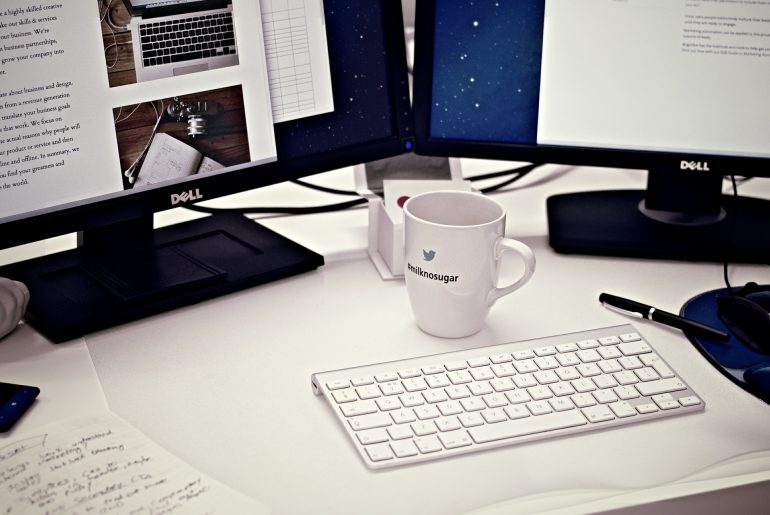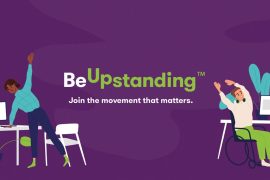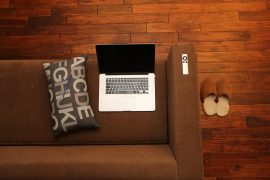This article was posted by the ABC online on the 31st March, 2020. You can find the original article here.
Working from home during coronavirus shutdown? These hacks may help keep ease the pain of your home office
Kitchen benchtops and dining room tables around Australia have become workspaces as office workers have been advised to work from home in the face of the coronavirus pandemic. Where the opportunity to work from home in your PJs might have once seemed like a treat, the rapid shift to working from home — if that is even an option for you — is challenging. Suddenly, you may find yourself working in the same space as your family, bent over a laptop instead of sitting or standing at a dedicated workstation with ergonomic equipment.
The combination of long hours on a laptop on the kitchen table can be both physically and psychologically stressful over the long haul. “It’s worth investing some time thinking about how to make this work to protect your physical and mental wellbeing,” said Jodi Oakman, who leads the Centre for Ergonomics and Human Factors at La Trobe University. Here are some tips and hacks that may help you make your home workspace healthier, keeping in mind it may not be possible to set up the ideal workstation in the current crisis.
Sitting vs standing
Some people prefer to sit, others prefer to stand but if there’s one piece of advice Dr Oakman wanted to highlight it is to move, move, move. “Both sitting and standing for long periods of time is problematic,” she said. Ideally, she said, you should alternate between sitting and standing.
In either position there are some basic rules to try to follow:
- You should maintain a symmetrical body position — do not cross your legs, or lean over or twist your body
- Your arms should be above the desk. A good way of checking this is making sure your arms are flat on the surface when your elbows are 90 degrees and tucked into your side
- Your screen/keyboard/work surface should be directly in front of you
- If you use two screens they should be at a similar height and side by side to avoid too much twisting
- Your eyes should be level with the top — or just below the top — of your screen
- Your screen should be about an arm’s length away from you
- Your hips should be flexed between 90 to 110 degrees if you are sitting
- You should have support in the lower part of your back if you are sitting to help prevent fatigue
- Your feet should be flat on the floor (or resting on a footrest to keep your hips bent in the right position).
Not surprisingly, it is impossible to achieve this position with just a laptop.
“Because they’re a smaller screen that is fixed to the keyboard it forces you into a flexed position so your head and back are bent or flexed,” Dr Oakman said.
Added to that, your average kitchen chair just doesn’t cut it.
“Kitchen chairs are often too low to sit at kitchen tables for most people, so that impacts your elbow and neck.”
Take regular breaks
When we work from home we become a lot more sedentary.
“We don’t have to walk and get a coffee, or speak to someone on a different floor, or catch public transport,” Dr Oakman said.
So we need to put triggers in place to remind us to move and break up the day.
This is important for everyone, but particularly if you are working at a far-from-ideal workstation.
“Work out what might work for you to signal those breaks. Some people use devices to set alarms or get up on the hour to do something.”
Staring at a screen for long periods of time can also irritate your eyes so it is recommended that you:
- Look at something in the distance every 20 minutes or so
- Remind yourself to blink regularly
General exercise is important too.
“Both for immunity but also to help protect against being sedentary at your makeshift desk which may or may not be as good as at work.”
Workstation tips and hacks
Not everyone will be fortunate enough to have a proper desk, chair and computer screen in their home, but there are some ways you may be able to improve your makeshift office.
(These are general tips and may not work for everyone. You should see if your employer has requirements such as a checklist you need to follow and, if you need specific advice, get in touch with a qualified health professional.)
If you have a limited budget just having an external keyboard and mouse for your laptop will make a big difference, Dr Oakman said.
“Having a separate peripherals gives you a lot more flexibility.”
“Just get your keyboard and mouse and then you can build [a sitting or standing station] around it.
Once you’ve got a separate keyboard and mouse you can raise the height of your laptop on a pile of books to get it to the right height.
Laptops often have small screens which can be an issue for some people, so a separate screen is also a good idea.
If you can’t afford to buy one or there’s none left on the shelves, Dr Oakman suggested negotiating with your employer to borrow a screen. Another option is to use a small TV screen if you have a spare or bump up the font size to make it easier to read.
If you’re planning to do most of your work sitting down Dr Oakman said having an adjustable chair — even a cheap one — is a good idea. This can help make sure you are working at a good height and your back is supported. Alternatively, ask if you can borrow your chair from your employer, she suggested. If that’s not possible, use the tallest chair you have — but not a stool — and put something on it so you’re sitting at the right height.
“And if you need to have a footstool, find something an old shoe box, books, whatever you’ve got that fills in that gap between your feet and your floor.”
You will also need a lumbar support but using a rolled-up towel should be the last resort, Dr Oakman said.
“Towels flatten out, they move around and they are hard to get right, so they’re really only good for the short term while you find something more sustainable.”
Using a headset or earphones for calls will allow you to get up and walk around, and you can tune out background noises.
“Lots of people already have that with their phones but that can be quite useful, particularly because most of us are doing meetings now for hours online.”
“If you do your calls standing up and your work sitting down it gives you that flexibility of movement.”
Where to set up your workstation
If you have a choice of where to set up, lighting is important.
Preferably you need to orientate yourself so that you don’t get too much light on the screen, particularly if it is a laptop which can be harder to see.
“Don’t have direct light on your screen but have light coming in over your shoulder, have an overhead light, or use a task light or desk lamp.”
If you prefer to have your screen in front of a window so you can stare into the distance keep in mind it may increase the screen contrast. In this case use blinds to control the direction of the light.
Setting boundaries between work and home
Finally, THE most important aspect of working from home is to set boundaries.
“A lot of us like to keep a semblance of separation [between home and work] and that can be very difficult now because we’re all here at home coupled with the fact we’re not going out,” Dr Oakman said.
Working from home also means we can end up working much longer days.
Setting up a designated space can signal when you are and aren’t working.
While some people may be fortunate enough to have an office, others will be negotiating space in shared rooms.
Dr Oakman said strategies such as moving the workstation to the end of the table, putting it away or covering it up at the end of the day can help to signal when you are and aren’t working to others.
It also gives yourself permission to say ‘I’ve done enough’ for the day, she said.













Comments are closed.